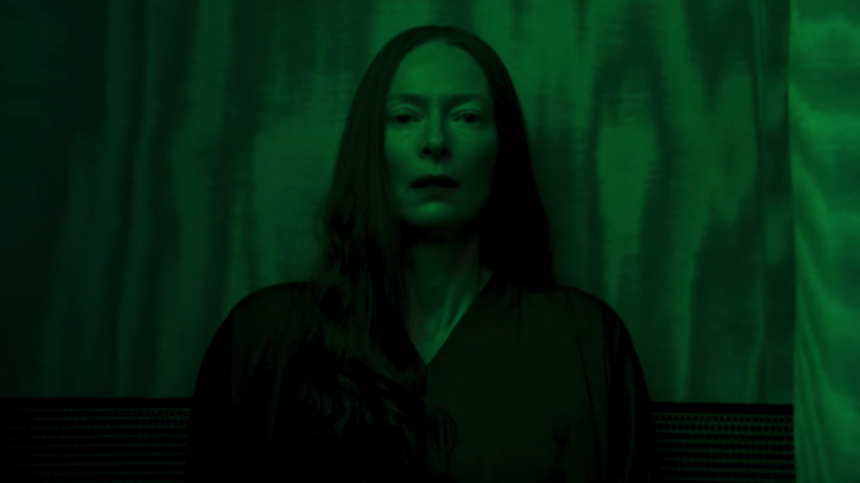Suspiria Review

Memorable horror movies cast a spell. These are works that don't so much rely on popcorn fluff jump scares, but rather, focus on the venerable credo of psychological trepidation. I'm not talking the stuff that repeatedly appears at your local Cineplex, no, I am hinting at the select few that burrow themselves so deep inside of us that we can feel the fear eating our soul. So it makes perfect sense that Luca Guadagnino's first try at the genre finds inspiration in the work of Fassbinder and Dario Argento's 1977 "Suspiria"--to which he is a lifelong fan. And yet, the real scare is how little it seems to work.
From peaches to pears, the Italian auter follows up his zestful tale of true loves harmony, "Call Me By Your Name",--not so much a spell, but spellbinding-- with ostensibly a high-brow gore fest. Its a shame his revered eroticism doesn't make a bigger splash in red waters. You get the sense that maybe he should stick to love stories. Though you won't doubt the directors intellect or his ability to transport an audience for a second. Much like the original, this presents itself as sybaritic overload. It's as classy as big screen horror gets, what with the textbook blaring reds and jazzy blues reflecting off the the frigid earth tones of 1977 Berlin. This jaw-dropping historical backdrop is wonderfully if not eerily atmospheric, and comes with four course meal of artsy zooms and pans, a grand marble dance hall with more patterns then secret passage ways--in other words, a playground for alarming images--, Sayombhu Mukdeeprom's brilliant framing, and for desert, Thom Yorke's(Radiohead) devilishly satisfying score that sounds like a fading cry for help.
However, what makes this remake unsatisfying is its substance, and believe me, you can forget about whatever apatite you built up in the last paragraph. Not that the snapping spines, pools of velvet blood, and meat hooks penetrating flabby skin are off-putting, well, they are, but they don't make a mess of the subject.(With exception to a bloodbath climax that tries to make imploding naked bodies a sensual climax). Humans eating gore doesn't embody breaking news, but the message that lies beneath it certainly does. Don't be fooled, there is a reason the sequestered Dance Academy towers above the concrete Berlin Wall. Just as there is a reason these females rise from the ashes(yay for female empowerment!). Which all just seems silly given the witches/heroes(?) here are out to "break the nose of every beautiful thing".
The heroine, if you can call her that, is Susie Bannion(Dakota Johnson in a career defining role), a sharp young dancer who has just moved from the Ohio countryside, leaving her faithful Christian family behind. (Johnson steps outside the box for a chilling role that trades "50 Shades of Grey and Bland" for "50 Shades of Red and Damned"). It isn't a spoiler to say she is accepted into the prestigious dance school of her dreams(literally). Claiming that through her dreams, the place had been calling her name on a metaphysical level. So it's no surprise that she lands the main role in a modernist dance number that borders animalistic; the pounding feet and swift arching backs of the near-nude possessed is yet another contrast to the original, and its sweeping Russian styled ballet. Though the spot did open due to an insoluble disappearance of a dancer(Chloe Grace Moretz), it's choreography maestro Madame Blanc that sees something in her(also literally). Tilda Swinton miraculously plays both her characters with an incomparable sense of impending doom. She plays the stone-faced Blanc and "allegedly" the unlikely detective Dr. Jozeph, a holocaust survivor permeating with prosthetic makeups and fear for the innocent girls.
The whole film is brimming with Bergman like fear and dread. But it just isn't scary. Nor does its ambitious ideas lead to any sort of epiphany or coherent meaning. Yes, it is entertaining, but it also is a work without heroes, morals, or direction. Which would be fine if we weren't supposed to root for these sadist witch metaphors that parallel the radicals of the Cold War era.
If D.W. Griffith's "Birth of a Nation" was racy but distasteful, then Guadagnino's birth of a nation is downright repulsive. I don't mean that entirely in a bad way. But the idea to use dancing witches as a metaphor for "German Autumn" and the rising dynamism of the Red Army Fraction(RAF) probably wasn't the dynamite idea the director thought it would be. Sure, any movie about witches seems to sell these days, but at times it feels this one doesn't know which way it wants to go.
3/5

Do you feel this content is inappropriate or infringes upon your rights? Click here to report it, or see our DMCA policy.





